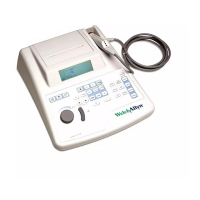6
51
Test Results
Ear Canal Volume - Tympanometry
Normal
As a general rule, values for ear canal volume should be between 0.2 and 2.0 cm
3
.
However, the normal values will vary with age and bone structure.
Abnormal
An ear canal value of less than 0.2 cm
3
indicates an abnormal condition. If the probe is
partially plugged with cerumen or if the probe is positioned against the ear canal wall, a
smaller than expected value will be measured. Also, if an individual has a relatively large
bone structure for his/her age group and a smaller than expected value is measured, the
probe could also be partially occluded or against the canal wall. It is also possible to
collapse the canal if the probe is held too firmly against it. Examine the Tympanogram and
the reflex results to confirm results. If they are abnormal as well, it is good practice to
repeat the test.
An ear canal volume greater than 2.0 cm
3
also may indicate an abnormal condition. An
important application of the ear canal volume measurement is to determine if there is a
perforation of the tympanic membrane. If there is a perforation due to trauma or due to
the presence of a pressure-equalization (P-E) tube, the measured ear canal volume will be
much larger than normal since the combined volume of the ear canal and the middle-ear
space is being measured. The maximum ECV is 5.0 cm
3
, any space larger than that will
be recorded as 5.0 cm
3
or may not seal.
Compliance Peak
Normal
The range of normals for compliance is 0.2 cm
3
to approximately 1.4 cm
3
. Some protocols
use a larger range up to 1.8 cm
3
. A measured compliance peak within this range indicates
normal mobility within the middle-ear system.
Abnormal
A compliance value of less than 0.2 cm
3
indicates a pathological condition as the middle-
ear system is stiffer than normal. To distinguish the probable cause of the stiffening, the
pressure value where this stiffened compliance peak occurs needs to be considered. For
example, normal pressure along with a stiff middle ear system is indicative of
otosclerosis, a severely scarred tympanic membrane or a layer of plaque across the
tympanic membrane. On the other hand, abnormal pressure along with a stiffened

